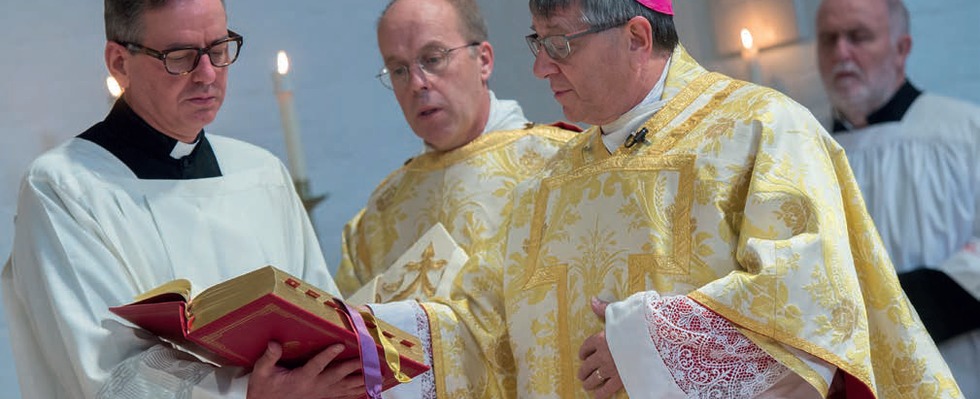Interview A response to a call – and a look ahead
Article:
08.01.20
Interview
A response to a call – and a look ahead
Joanna Bogle talks to Fr Christopher Pearson at the Ordinariate and parish church at The Borough, London Bridge
The church stands in a rapidly-changing corner of South London near the Thames. The oddly-named Flat Iron Square opposite is busy with clubs, bars and restaurants and London Bridge nearby has been the scene of two terrorist attacks, in 2017 and in 2019.
The brick building with its twin bell towers is floodlit at night and a major part of the scene. Assumed by many to be earmarked for closure a decade ago, the Church of the Most Precious Blood has been recently renovated and – more than a century after it was first opened – consecrated. Then as 2019 drew to a close, it received its first-ever visit from a Cardinal.
This has been a busy time for Father Christopher Pearson, who, as an Anglican clergyman in 2010 accepted the invitation from Pope Benedict XVI in Anglicanorum Coetibus to come into full communion with the Catholic Church along with a substantial number of his flock.
Union
As vicar of St Agnes Church, Kennington, he had always seen union with the Catholic Church as the way ahead and when the Pope issued this direct call, there could, he says “really only be one response.” He took a journey into an unknown future – the Church does not and cannot automatically offer ordination. But when, after due instruction and Confirmation the group became part of the Catholic Church, and he was accepted for the priesthood, he was ordained at St George’s Cathedral, Southwark, and a new chapter began.
The Church of the Most Precious Blood – or MPB as many parishioners call it – was given to the care of the Ordinariate of Our Lady of Walsingham in January 2013. A fine 19th century building, it required some urgent attention. First project was new under-floor heating, and a full restoration of the sacristy which - because proper church heating in winter had been abandoned on weekdays for some years – had been turned into a makeshift weekday chapel. Its transformation, complete with discovery of a lantern window that had been covered by polystyrene ceiling tiles, revealed the possibilities for further projects, while the new heating brought rising numbers into the church for the daily 1.05pm lunchtime Mass and the Sunday Masses.
Team effort
“It’s been a team effort – anything like this has to be” says Fr Christopher, reflecting in a noisy parish room over post-Mass coffee on a winter morning as 2019 draws to a close. He isn’t smug: recent discoveries of dry rot in the beams in the church roof will require scaffolding and fresh work. But he and the team could surely allow themselves a certain sense of achievement. After much hard work and fund-raising efforts, the church has been restored to its original glory – its baldachino gleaming in white and gold, a fine marble floor in red and grey reflecting the theme of the church’s name, and a magnificent new font – an exact replica of the original – in place and in regular use for baptisms.
The summer of 2019 saw the consecration of the church – “I went through all the records, and found, to my surprise, that it had never been consecrated, so once all the work was done that was obviously the next thing to do” – by Archbishop Peter Smith of Southwark in one of his last public acts before his retirement. It was a memorable day – the children’s choir, established and trained by the able choir director and churchwarden Christopher Smith – sang Anglican and Latin chant, and a packed congregation watched as the walls were anointed in a joint action by Archbishop Peter and by Mgr Keith Newton of the Ordinariate.
“They took one wall each, anointing with oil. And the relics were placed in the altar by the man who had carried out the restoration work there, and the flowers by the regular flower team. Everything was done by the people who had been involved from the beginning.”
Historic
The day might be regarded as one of historic significance – but was perhaps topped by one in November, when Cardinal Vincent Nichols came to preach at a Mass marking the 10th anniversary of Anglicanorum Coetibus. This marked another first for the parish – no Cardinal had ever visited this corner of South London before.
“We’ve got lots of history here – from martyrs held in the Clink prison in the 16th century to immigrants settling in the 19th and 20th – but a Cardinal arriving was something new.” Fr Christopher’s own spiritual journey began at the Minster in Sheppey when, as a chorister and altar-server he was first introduced to the thought of priesthood. In the sacristy at MPB he has pictures of his parents and of the Anglican vicar who first inspired him to consider a vocation.
Like others in the Ordinariate, he is looking forward rather than backward following the 10th anniversary celebrations. “We met recently to seek the vision for the future. The last ten years have seen something established and now we look ahead.”
Notes:
Joanna Bogle is editor of Faith magazine.






